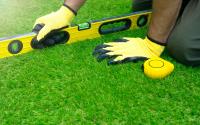 Add My Company
Add My Company
Sign In
How to Lay Artificial Grass on Uneven Ground
01-02-2021

If you have an uneven area where you wish to lay artificial grass, your first course of action should be to landscape it to create level ground. This is because, when installing synthetic turf on uneven ground, there is a much higher chance of mistakes such as uneven joins, unsecured edges and visible imperfections in the surface.
The Artificial Lawn Company’s installation team will always begin by landscaping your garden/outdoor area, ensuring there is an even surface to work with. Our team are experts when it comes to how to level out a sloping garden and removing imperfections such as weeds, roots and mounds – all of which can and will result in complications once the artificial grass has been installed.
Why Should Artificial Grass be Laid Level?
There are both technical and aesthetic reasons as to why your new artificial grass should be laid on level ground. Purely from an aesthetic point of view, the sight of visible imperfections such as bumps in the surface are unsightly. As it is not a case of just simply digging the surface up and smoothing out the problem area, the surface must be level before laying down any turf.
As well as being an inconvenience, those bumps can present a safety issue – especially for homes with children who are likely to want to run and play on the grass. When the ground surface is level, the naturally soft surface, mixed with the sub-base, will cushion any tumble, reducing the risk of injury. When the turf is uneven, the chances of someone tripping and hurting themselves is increased and they won’t necessarily land on a cushioned, even surface, potentially landing on an awkward area that could cause a nasty injury.
From a technical perspective, there are even more reasons why you should not lay artificial grass on uneven surfaces. Doing so may hamper the turf’s drainage systems and weed barrier, which will likely result in your grass becoming waterlogged as it is unable to drain away standing water as well as it would on an even surface. Weeds are also more likely to be able to push through, especially at the seams of your turf where you could expect to find unsecured edges and uneven joins due to the imperfections in how the grass has been laid.
How to Level Out Your Ground
Now that we have established why the ground should be level prior to the installation of artificial grass, you may wish to know how you can easily level out the area you are planning to lay your new turf. If you are opting to install the turf yourself, it will require a little bit of elbow grease but, depending on the size of the area, you should be able to get this done in a day.
First, begin by digging up the area where you plan to lay your turf, removing any old grass and/or concrete patio that may have been there before. Once this is done, the next step is to smooth out the surface by laying a sub-base on top of the ground as this will make for a soft and even surface upon which to lay down the artificial grass. Please refer to our install instructions for more detailed information.
If you want to guarantee a perfect finish and you are based inside our catchment area, you can call on the services of Artificial Lawn Company’s installation team. Not only will our team carry out the work quickly and efficiently, but they will also take away any rubbish and offcuts that you don’t wish to keep, leaving you with a clean and tidy garden that benefits from a professionally installed artificial lawn.
Other Complications of Laying Artificial Grass on Uneven Ground
We have already highlighted the issues surrounding uneven joins, imperfections and the potential for weeds and standing water, but that isn’t where the issues begin and end. Artificial grass is designed to last for years with minimal maintenance, but with such issues after installation, that simply won’t be the case.
When the surface is impeded with a lack of drainage and imperfections, the lifespan of the turf is shortened as it is more likely to suffer from damage. Not only that, when you can clearly see imperfections such as an uneven surface, you don’t want to have to look at it every day. Unfortunately, the only way to rectify it once the turf has been laid is to pull it all back up and start again.
That can be time-consuming, expensive and frustrating. Pulling up artificial grass should be done carefully if you are hoping to use it again once the ground has been levelled off, although there is the possibility that once the surface is even, the measurements and joins will be off. Potentially, you may have to invest in new artificial grass – highlighting the importance of making sure the job is done right the first time around.
When you are asked if you can lay artificial grass on uneven ground, the answer is no – at least not if you want the job done correctly. Our installation guide walks you through each of the steps to installing artificial grass to the same standard as our team of experienced professionals. You can decide to call on their services if you aren’t confident or don’t have the time to lay it yourself.
For more information, please do not hesitate to get in contact with a member of the Artificial Lawn Company team today and we will be more than happy to help.
For more information on How to Lay Artificial Grass on Uneven Ground talk to Artificial Lawn Company
Enquire Now
List your company on FindTheNeedle.
